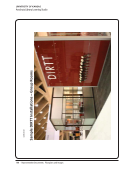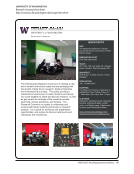42 · Survey Results: Survey Questions and Responses
Some librarians who had previously volunteered to work the reference desk declined to continue to do so when we
moved in with circulation staff. I believe it was because they did not want to be responsible for or learn about circulation
procedures and tasks. Nor did they want to be the “person in charge” which often happens when you’re the only one or
one of a few faculty/staff in the CSP space and the student employees look to you for answers. Consequently, we had
to rely on long-time circulation staff with little or no reference skills to staff what is the busiest service point in the entire
library.
Staff continued to do work related to document delivery/ILL, but without responsibility for check out, and from an
existing behind-the-scenes location.
Staff from the consolidated service points (Circulation/Reserves) have had to cross train and to adjust to a new model
for desk staffing. Stacks management staff, who were in close proximity to the circulation desk before, have had to
adjust to being more physically distant from the circulation desk. Approximately 20 staff were affected in one way or
another. Prior to the consolidation, several units were combined into an Access Services department. So there was some
change in reporting structure but not because of the service point consolidation.
Staff had basic training in question answering and when to refer collections librarians had training in reference desk
procedures and virtual reference etiquette all had to maintain a little more cooperative relationship with each other.
Staffing at Circulation enabled 8–midnight IM coverage reference desk hours trimmed to leave more time for reference
and collections librarians to develop relationships outside the library walls and develop new tools for information
dissemination (learning objects, research guides [web], virtual services).
Staff were not impacted student employment was reduced.
Staff who didn’t previously report through the Access Services department now have a dotted reporting line through
them.
Support staff went into layoff status and were hired to fill other positions within the University Library.
Ten librarians and staff now do all of their reference time at the Learning Commons Desk or from their offices.
The change was fairly seamless.
The consolidation of media with music media has brought about cross training of staff from each of the two formerly
separate centers. Some reporting relationships changed, and a new manager of our adjacent Sharon Fordham Lab was
hired.
The librarian no longer supervised staff although this changed recently with other organizational changes. One support
staff was reassigned to a vacant position in another science library and the other support staff was transferred to a
vacant position in the circulation unit of the main library.
The new 24/7 space is staffed by student assistants from IT and supervised by staff from IT. There is a joint group of IT
staff and library staff (primarily staff from Circulation and Reference) who collaborate and help determine the services
needed and provided, the training needed, and the configuration of the physical space. A security officer was hired to
be in the space during the overnight hours.
The staffing impact was the ability to redeploy student assistants to a very busy service desk in the media department.
The subject specialist moved to the Main Library. The two support staff were transferred to different branches.
The teams of Access Services were reorganized to accommodate the change in service points, including consolidating
branch library staff into one team, creating a new service desk team, and establishing the stacks team as a separate
team (the stacks and circulation teams had been one team previously).
Some librarians who had previously volunteered to work the reference desk declined to continue to do so when we
moved in with circulation staff. I believe it was because they did not want to be responsible for or learn about circulation
procedures and tasks. Nor did they want to be the “person in charge” which often happens when you’re the only one or
one of a few faculty/staff in the CSP space and the student employees look to you for answers. Consequently, we had
to rely on long-time circulation staff with little or no reference skills to staff what is the busiest service point in the entire
library.
Staff continued to do work related to document delivery/ILL, but without responsibility for check out, and from an
existing behind-the-scenes location.
Staff from the consolidated service points (Circulation/Reserves) have had to cross train and to adjust to a new model
for desk staffing. Stacks management staff, who were in close proximity to the circulation desk before, have had to
adjust to being more physically distant from the circulation desk. Approximately 20 staff were affected in one way or
another. Prior to the consolidation, several units were combined into an Access Services department. So there was some
change in reporting structure but not because of the service point consolidation.
Staff had basic training in question answering and when to refer collections librarians had training in reference desk
procedures and virtual reference etiquette all had to maintain a little more cooperative relationship with each other.
Staffing at Circulation enabled 8–midnight IM coverage reference desk hours trimmed to leave more time for reference
and collections librarians to develop relationships outside the library walls and develop new tools for information
dissemination (learning objects, research guides [web], virtual services).
Staff were not impacted student employment was reduced.
Staff who didn’t previously report through the Access Services department now have a dotted reporting line through
them.
Support staff went into layoff status and were hired to fill other positions within the University Library.
Ten librarians and staff now do all of their reference time at the Learning Commons Desk or from their offices.
The change was fairly seamless.
The consolidation of media with music media has brought about cross training of staff from each of the two formerly
separate centers. Some reporting relationships changed, and a new manager of our adjacent Sharon Fordham Lab was
hired.
The librarian no longer supervised staff although this changed recently with other organizational changes. One support
staff was reassigned to a vacant position in another science library and the other support staff was transferred to a
vacant position in the circulation unit of the main library.
The new 24/7 space is staffed by student assistants from IT and supervised by staff from IT. There is a joint group of IT
staff and library staff (primarily staff from Circulation and Reference) who collaborate and help determine the services
needed and provided, the training needed, and the configuration of the physical space. A security officer was hired to
be in the space during the overnight hours.
The staffing impact was the ability to redeploy student assistants to a very busy service desk in the media department.
The subject specialist moved to the Main Library. The two support staff were transferred to different branches.
The teams of Access Services were reorganized to accommodate the change in service points, including consolidating
branch library staff into one team, creating a new service desk team, and establishing the stacks team as a separate
team (the stacks and circulation teams had been one team previously).






















































































































































































































